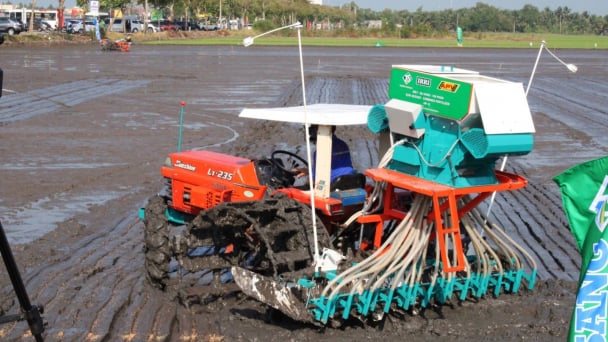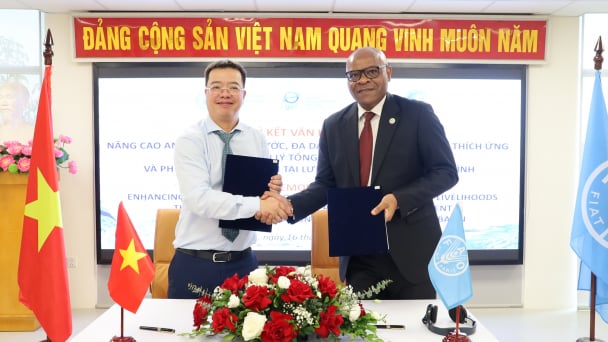May 19, 2025 | 13:21 GMT +7
May 19, 2025 | 13:21 GMT +7
Hotline: 0913.378.918
May 19, 2025 | 13:21 GMT +7
Hotline: 0913.378.918
On the morning of August 16, experts presented additional information regarding Vietnam's determination to the Net Zero roadmap, the operational mechanism, the carbon credit market, and low-emission production during the seminar on carbon credits.
The Carbon Border Adjustment Mechanism (CBAM) of the European Union was one of the primary topics of interest. This mechanism applies to six industries: steel, cement, aluminum, electricity, and fertilizers.

CBAM imposes a carbon tax on all products imported into EU member countries.
Based on the intensity of greenhouse gas emissions in the exporting country's production process, CBAM imposes a carbon tax on all products imported into EU member countries.
CBAM was established under Regulation 2023/956 of the European Council and Parliament to become a carbon-neutral region by 2050. This mechanism is intended to prevent "carbon leakage," which is the scenario in which EU businesses relocate carbon-intensive production activities overseas to capitalize on more permissive compliance standards. It establishes a green mechanism for imported products from outside the EU by implementing a system that provides a fair price for the carbon emissions produced during production, thereby promoting low-emission production.
Based on the intensity of greenhouse gas emissions in the exporting country's production process, CBAM imposes a carbon tax on all products imported into EU member countries. This taxation is a critical component of Europe's climate policies and is one of the mechanisms through which the EU motivates its trade partners to decarbonize their production sectors.
Consequently, importers who enter the EU through the CBAM mechanism must register with domestic regulatory authorities and acquire CBAM certificates. The weekly carbon credit prices of the European Union Emissions Trading System (EU ETS) are the basis for the price of these certificates. Importers in the European Union are required to declare the emission content of imported goods and submit the commensurate number of certificates annually. The corresponding emissions can be deducted if the importer can demonstrate that carbon costs have already been paid during the production of the imported products.
Before products can be imported into the EU, importers are pre-approved under this mechanism. Nevertheless, they must report the embedded emissions of imported products and acquire and submit certificates for each ton of embedded emissions.

Mr. Dang Thanh Long, Head of Training and Sustainable Development at Intertek Vietnam. Photo: Nguyen Thuy.
The six categories of products covered by CBAM involve over 10,000 businesses, according to Mr. Dang Thanh Long, Head of Training and Sustainable Development at Intertek Vietnam, a company that specializes in assurance, testing, inspection, and certification. These products are utilized as inputs for three significant European sectors: energy, industry, and aviation, all of which are involved in the EU ETS market.
Since 2005, the EU ETS has mandated that businesses in a variety of industrial sectors within the EU pay for each ton of carbon that is released into the environment. One of the most effective solutions for regulating annual carbon emissions in accordance with the Paris Agreement on climate change, which was signed in 2015, is the carbon tax.
Nevertheless, specific exemptions are granted to products imported into Europe from third countries. The implementation is divided into two phases. From October 1, 2023, to December 31, 2025 (the learning phase), companies that import six categories of goods into Europe are required to declare the embedded emissions in their products, become familiar with the CBAM mechanism, and allow Europe to collect data in order to issue precise mechanisms and quotas. Importers of these six categories of goods are required to pay carbon emission fees for each ton of imported goods in accordance with the quotas beginning on January 1, 2026 (the application phase).
The economic impact of CBAM on Vietnam is not substantial. Nevertheless, the reduction in export value is substantial for certain industries and businesses, which places additional pressure on companies.
Mr. Long observed that commodities exported to Europe will be required to pay 100% of the carbon fees for emissions that exceed the quota, as Vietnam has not yet established a carbon credit trading market. In contrast, CBAM-covered products exported to Europe will be eligible for carbon fee deductions once a carbon credit market is established and exporters have already paid carbon fees in Vietnam. Consequently, businesses will incur losses if the carbon credit market operates tardily.
Mr. Long recommended that producers in third countries compute the "embedded" emissions in their exported goods, which includes both direct and indirect emissions, when engaging in CBAM trading, which is similar to stock market trading mechanisms.
Translated by Linh Linh

(VAN) The German Agricultural Society (DLG) explores the possibility of establishing a mechanization service center in Vietnam’s Mekong Delta to support farmers in accessing and utilizing advanced machinery.

(VAN) On May 16, the Department of Water Resources Management, in collaboration with the Food and Agriculture Organization of the United Nations (FAO), held a signing ceremony for the GEF-8 project document.

(VAN) Food safety, mechanization, vocational training, and market opening are key areas of cooperation expected between the Vietnamese Government and the Federal Republic of Germany.

(VAN) Deputy Minister Nguyen Quoc Tri also expressed his hope that Cuba will soon overcome its current challenges, attain food security, and further expand cooperation with Vietnam.

(VAN) The project contributes to enhancing the resilience of communities vulnerable to the impacts of climate change, with a primary focus on local women.

(VAN) Green materials help save energy and resources. However, after more than 10 years, Vietnam has only developed over 200 green buildings with more than 6 million square meters of floor space.

(VAN) Vietnam - Thailand Business Forum 2025: One plus one on three connects, marking a milestone in the comprehensive strategic partnership between the two nations.